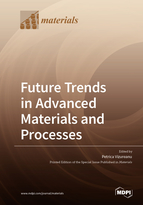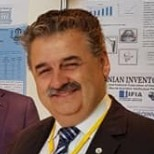Future Trends in Advanced Materials and Processes
A special issue of Materials (ISSN 1996-1944). This special issue belongs to the section "Manufacturing Processes and Systems".
Deadline for manuscript submissions: closed (15 June 2022) | Viewed by 42461
Special Issue Editor
Interests: material processing engineering; heat treatment; corrosion; hard coating; biomedical and aeronautical applications; biomaterials; geopolymers; expert systems
Special Issues, Collections and Topics in MDPI journals
Special Issue Information
Dear Colleagues,
This Special Issue will contain original high-quality research papers covering the most recent advances in materials properties, as well as comprehensive reviews addressing the relevant state-of-the-art topics in the area of materials processing, with relevant practical applications.
The Special Issue “Future Trends in Advanced Materials and Processes” will mainly cover the characterization of materials focusing on the relevant or innovative applications of such an approach.
In particular, the topics of interest include, but are not limited to:
- Mechanical coating/alloying/treatment of the metallic and non-metallic materials;
- Thermo/chemical treatment of the metallic and non-metallic materials;
- Nonconventional treatment applied to materials, such as: thermo/mechanical coating, including machining (electrochemical/abrasive), shot blasting or peening;
- Biomaterials coatings applied on, but not limited to, Ti-based alloys, CoCr alloys, stainless steels.
In advance, we would like to gratefully acknowledge the authors and reviewers who will participate in the elaboration of this Special Issue, who will contribute to the development of the research on nanocolloids.
Prof. Dr. Petrica Vizureanu
Guest Editor
Manuscript Submission Information
Manuscripts should be submitted online at www.mdpi.com by registering and logging in to this website. Once you are registered, click here to go to the submission form. Manuscripts can be submitted until the deadline. All submissions that pass pre-check are peer-reviewed. Accepted papers will be published continuously in the journal (as soon as accepted) and will be listed together on the special issue website. Research articles, review articles as well as short communications are invited. For planned papers, a title and short abstract (about 100 words) can be sent to the Editorial Office for announcement on this website.
Submitted manuscripts should not have been published previously, nor be under consideration for publication elsewhere (except conference proceedings papers). All manuscripts are thoroughly refereed through a single-blind peer-review process. A guide for authors and other relevant information for submission of manuscripts is available on the Instructions for Authors page. Materials is an international peer-reviewed open access semimonthly journal published by MDPI.
Please visit the Instructions for Authors page before submitting a manuscript. The Article Processing Charge (APC) for publication in this open access journal is 2600 CHF (Swiss Francs). Submitted papers should be well formatted and use good English. Authors may use MDPI's English editing service prior to publication or during author revisions.
Keywords
- metallic materials
- ceramics
- composites
- biomaterials
- polymers
- geopolymers
- characterization
- application







